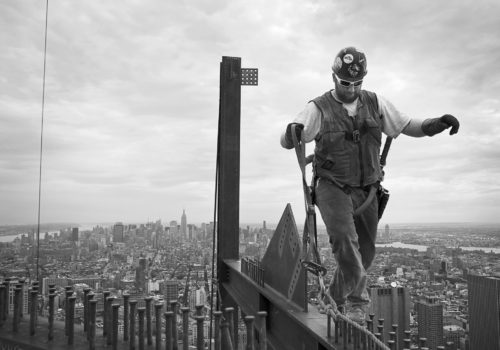It only took Damon Winter five days of work to equal Lewis Hine or Charles Ebbets. On the worksite of the new World Trade Center, the New York Times photographer covered the Ironworkers, those builders of American skyscrapers who are as much today as yesterday the city’s glory.
A poem. The word is just barely too strong. These photographs are linked together with rhymes. And yet every one of them is an icon, and, as with poetry, almost dissociable from the others, and this despite the fact that their primary purpose—to inform—is unaltered. The viewer always knows where he is, high up there 300 meters above the ground, with the workers who for more than a century have been building the canopies of New York.
Damon Winter has a great talent—that of transforming reportage into art. Confronted to Manhattan and its impregnable view, at an altitude where any photo can seem impressive, most would be tempted to snap away at the panorama with a wide angle lens and to incorporate within it a few scenes of people. But this photographer isn’t content just to photograph the view. He scrutinizes, zooms, composes, cuts off bodies, revolutionizes the framing, and it comes about practically naturally that the skyline then appears in the background. “I have always been very focused on what is happening in front of me,” he explains. “Generally speaking, I’m looking for the element of surprise. I notice the symbolism only afterwards, at publication.”
Even if he had in mind “those marvelous photos of the building of the Empire State Building during the 20s”, Damon Winter was intimidated when he arrived on the site last July. The workers were putting up the 73rd and 74th floors of the future “Freedom Tower.” It had taken months of negotiation to be allowed access. One doesn’t just enter like that among the Ironworkers—they have their own world. “The Port Authority officials were always watching me, I was not to bother the workers at their job, not to talk to them or have them pose. But as they weren’t paying any attention to me, I was able to stay in the background in order to capture good moments.”
Like many reporters, Damon Winter likes close contact. In all areas—from the hotel room of stars to the ruins of Port-au-Prince—he takes the time to establish relationships with the people he photographs. Sensitivity and gentleness: these are the constant qualities of this photographer and his photos “Finally, the workers came to see me. I spent time drinking beer and talking with them at the end of the day.”
Work conditions have changed considerably since the time of Charles Ebbets and his workers seated on a metal beam. Damon Winter had to accept certain conditions: a harness, a helmet, glasses and solid boots. However, even using digital, black and white is de rigueur. “It’s a reference to classical images but also to light conditions. This brilliant sun is very difficult to handle in color. In contrast, black and white enables one to overcome that problem and to provide a graphic effect.”
Jonas Cuénin
Note: This work was published the weekend of September 4 in the New York Times magazine on the occasion of the September 11, 2011.
















